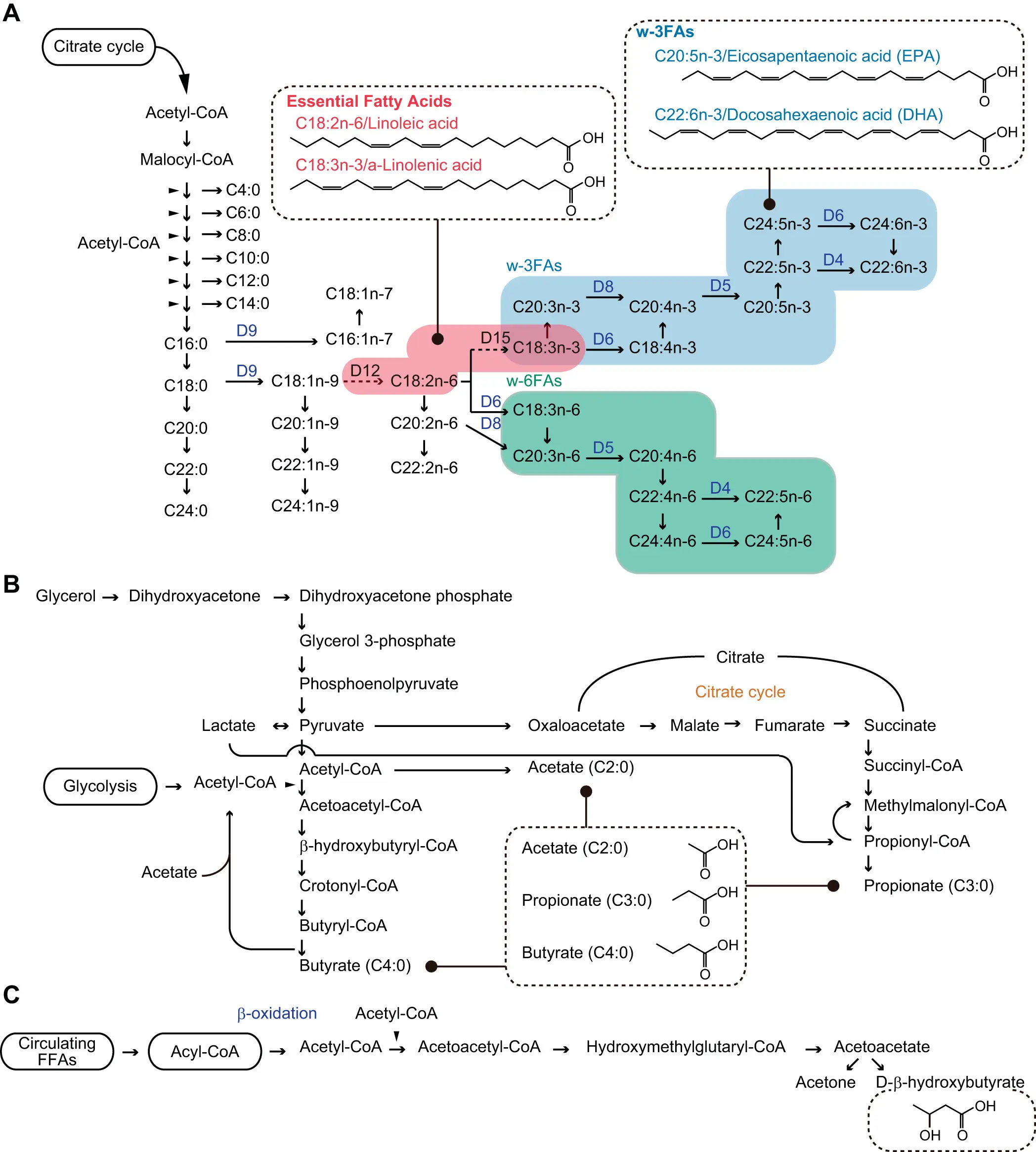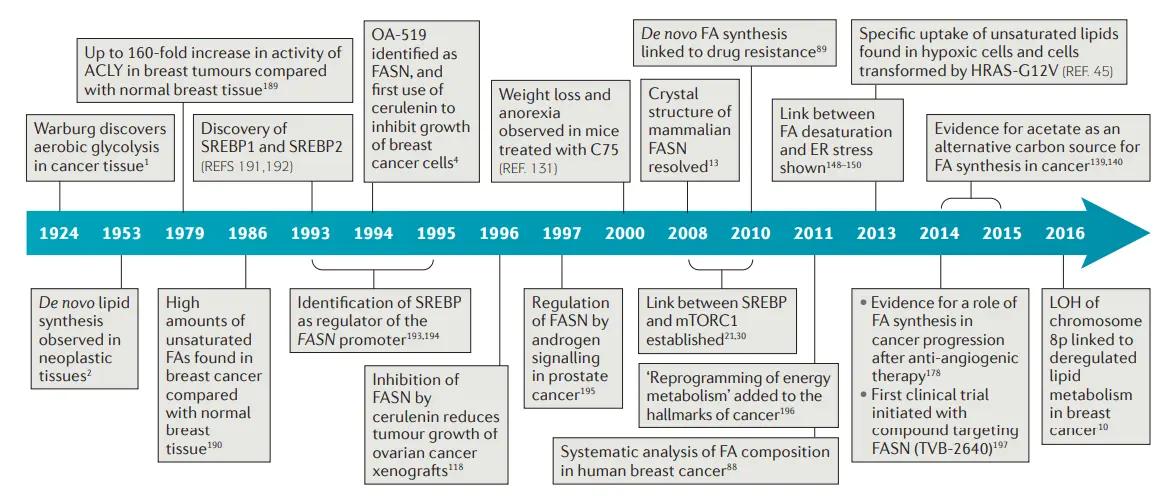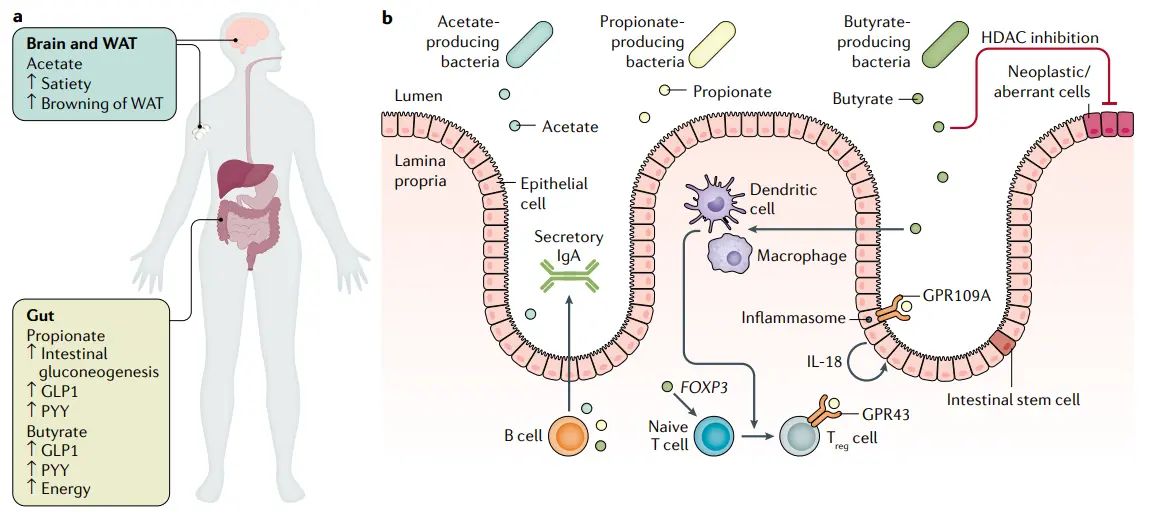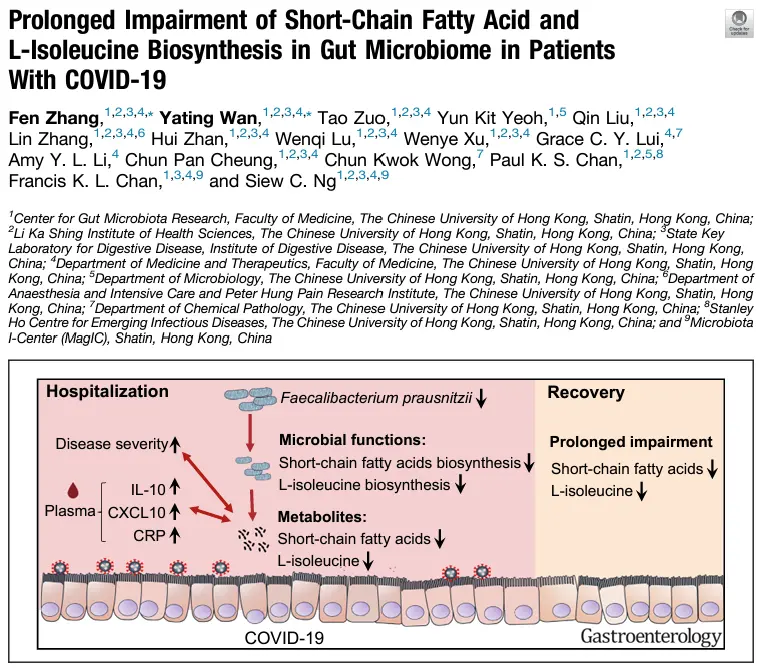Types of Fatty Acids: Classification, Functions & Role in Disease
1. What Are Fatty Acids?
Fatty acids (FAs) are a group of compounds composed of carbon, hydrogen, and oxygen. FAs exist widely in organisms and plays a very important role in life processes. They are an important nutrient and one of the main sources for energy. Many FAs are associated with many diseases including intestinal diseases, cardiovascular diseases, diabetes mellitus, severe liver disorders, and thyroid gland diseases, and thus their research, detection, and quantification is important in many biomedical research and clinical settings.
2. Types of Fatty Acids (SFA, MUFA, PUFA, SCFA)
1. Classification by the degree of saturation in the hydrocarbon chain
FAs can be divided into saturated fatty acid and unsaturated fatty acid according to their degree of saturation:
a. Saturated fatty acid: FAs that does not contain any unsaturated bonds.
b. Monounsaturated fatty acid: FAs that contain one unsaturated bond.
c. Polyunsaturated fatty acid: FAs that contain two or more double-bonds. Based on the positions of the double-bonds, these FAs can be divided into omega-3, omega-6, or other categories.
2. Classification by the length of carbon chain
a. Short chain fatty acid:FAs with number of carbon atoms between 1 and 6.
b. Medium chain fatty acid: FAs with number of carbon atoms between 6 and 12.
c. Long chain fatty acid: FAs with 12 or more carbon atoms.
Fatty Acid Types, Food Sources, and Their Functions in the Body
|
Type |
Example |
Food Source |
Key Role |
|
SFA |
Palmitic acid |
Butter, Lard |
Structural fat, energy |
|
MUFA |
Oleic acid |
Olive oil |
Heart health |
|
PUFA |
Linoleic acid |
Sunflower oil |
Anti-inflammatory |
|
SCFA |
Butyric acid |
Gut fermentation |
Gut health, immune modulation |
3. Essential vs Non-Essential Fatty Acids
Essential fatty acids (EFAs) refer to fatty acids that the human body cannot synthesize and must be acquired from the diet. The two primary EFAs are linoleic acid (omega-6) and alpha-linolenic acid (omega-3). These play vital roles in brain development, immune regulation, and anti-inflammatory signaling. Their downstream metabolites, such as EPA and DHA, are especially important for cardiovascular and cognitive health. In contrast, non-essential fatty acids can be synthesized endogenously. Maintaining the correct balance of omega-6 to omega-3 intake is crucial, as an imbalance may contribute to chronic inflammation. At MetwareBio, our lipid quantification services allow precise profiling of EFAs in blood, tissue, or dietary samples, helping researchers uncover the relationship between fatty acid intake and disease risk.
4. What Do Fatty Acids Do in the Body?
Fatty acids are not merely building blocks of fats—they perform numerous essential biological functions. They serve as a key energy source, especially during fasting or prolonged exercise, when glucose availability is limited. Structurally, fatty acids are incorporated into phospholipids, maintaining cell membrane integrity and fluidity. Functionally, fatty acids also act as signaling molecules. They influence gene expression through receptors like PPARs and modulate inflammation, cell proliferation, and lipid metabolism. Certain fatty acids, particularly omega-3s, are known to reduce systemic inflammation and support heart health. Understanding fatty acid functionality is critical in both nutritional science and disease research. MetwareBio offers lipidomics solutions to assess fatty acid functions across biological systems, providing insight into metabolic states and health conditions.
5. Fatty acid biosynthesis pathways
FAs are synthesized from carbohydrates in the adipose tissue, the liver, and the mammary gland. Carbohydrates are converted to acetyl-CoA by glycolysis, which is then cycled through TCA cycle to produce citric acid. This citric acid is transported to the cytoplasm and cleaved by ATP-citrate lyase to produce acetyl CoA. Through a series of iterative reactions, the fatty acid chain can extend by two carbons. In the presence of fatty acid synthase, seven malonyl-CoA and one acetyl-CoA are condensed to produce palmitic acid (FA 16: 0). Palmitic acid (FA 16: 0) undergoes C chain extension and desaturation by stearoyl-coa desaturase (SCD), ELOVLs and FADs to produce stearic acid (FA18: 0, FA 18: 1) and other fatty acids.

Figure from Kimura, Ikuo et al. “Free Fatty Acid Receptors in Health and Disease.” Physiological reviews vol. 100,1 (2020): 171-210. doi:10.1152/physrev.00041.2018
6. Research in fatty acid related diseases

Figure from Röhrig, Florian, and Almut Schulze. “The multifaceted roles of fatty acid synthesis in cancer.” Nature reviews. Cancer vol. 16,11 (2016): 732-749. doi:10.1038/nrc.2016.89
1. cardiovascular disease
A. Relationship with atherosclerosis
High concentration of free fatty acid can cause hyperfibrinogenemia, increase blood viscosity, and cause fibrinogen deposition in blood vessel wall, which can antagonize heparin. High fibrinogen often promotes platelet and red blood cell agglutination and decrease fibrinolytic activity such that the artery develops atherosclerosis.
B. Relationship with arrhythmias
In the early stage of acute myocardial infarction, myocardium increases it utilization of free fatty acid, and the free fatty acids in adipose tissue are mobilized to the blood and decrease the concentration of free Ca2+ in the blood. This uncouples oxidative phosphorylation and induce arrhythmia.
C. Relationship with ischemic myocardial contractility
High concentration of free fatty acid can further impair pump function of ischemic heart. While free fatty acid does not change the myocardial contractility under aerobic condition, but it can decrease the contractile force and increase the resting tension under hypoxic condition. The higher the concentration, the stronger the inhibitory effect, and may even lead to myocardial contracture.
2. Metabolic syndrome
Non-esterified fatty acids (NEFA) is the most active metabolic lipid in the human body with a half-life of only 2 ~ 3 minutes. It is an early and sensitive indicator of lipid metabolism disorders compared with TG, LDL, HDL and APOA1 / B.
A. Type 2 diabetes
NEFA in serum enhances glucose-stimulated insulin secretion (GSIS) within a physiological concentration range. However, long-term elevated NEFA can inhibit glucose oxidation and transport, inhibit glycogen synthesis, promote gluconeogenesis, affect insulin secretion and its signal transductions, and affect β cell apoptosis. Currently, monitoring and controlling the concentration of NEFA is becoming a new approach to prevent and treat type 2 diabetes.
B. Liver disease
High concentration of NEFA can induce hepatocyte mitochondrial swelling and increase its permeability, hepatocyte degeneration, necrosis and inflammation. Even very low concentrations of NEFA can change the permeability of the mucosa, leading to mucosal damage and injury of endothelial cells. Therefore, a small increase in NEFA concentrations in serum or liver can damage liver cells.
The occurrence of fatty liver is closely related to lipid metabolism disorder. In hyperlipidemia, the lipolysis of NEFA is accelerated, and increases NEFA content in the blood. When hepatocytes ingest too much NEFA and exceed the ability of mitochondria to oxidize NEFC, this promotes the synthesis of triglycerides (TGs). Fatty liver forms when the synthesis of TGs in hepatocyte is too fast and accumulates pass certain point.
C. Gastrointestinal diseases
SCFAs can reduce intestinal electrolyte associated diarrhea; butyric acid can be used to treat congenital chloride diarrhea; moderate levels of SCFAs can inhibit the growth of opportunistic pathogenic bacteria such as Escherichia coli and Shigella. However, high concentrations of SCFAs can damage the intestinal mucosa, and may be involved in the development of neonatal necrotizing enterocolitis.

Figure from Lavelle, Aonghus, and Harry Sokol. “Gut microbiota-derived metabolites as key actors in inflammatory bowel disease.” Nature reviews. Gastroenterology & hepatology vol. 17,4 (2020): 223-237. doi:10.1038/s41575-019-0258-z
3. Neurological disorders
SCFAs can regulate the maturation and function of microglia. Through gut-brain axis, SCFAs can also affect neurological diseases such as Parkinson's disease and Alzheimer's disease.
4. Immune diseases
Butyric acid are known to egulates the production, circulation and function of innate and adaptive immune cells.
5. Cancer
Fatty acid such as butyric acid and dihomogamma linolenic acid can inhibit the proliferation of some tumor cells and induce the differentiation and apoptosis of tumor cells.
7. Research Case study on Fatty Acid
Prolonged Impairment of Short-Chain Fatty Acid and L-Isoleucine Biosynthesis in Gut Microbiome in Patients with COVID-19
Zhang, Fen et al. Gastroenterology (2022). doi:10.1053/j.gastro.2021.10.013
Background
Coronavirus disease 2019 (COVID-19) caused by severe acute respiratory syndrome coronavirus 2 (SARS-CoV-2) infection is associated with altered gut microbiota composition. Phylogenetic groups of gut bacteria involved in the metabolism of short chain fatty acids (SCFAs) were depleted in SARS-CoV-2–infected patients. The authors aimed to characterize a functional profile of the gut microbiome in patients with COVID-19 before and after disease resolution. This study recruited 66 patients with COVID-19 treated with antibiotics and followed them from admission to 30 days after discharge. Changes in gut microbiota function and longitudinal dynamics associated with disease severity and immune response were characterized using metagenomics analysis. Targeted metabolomics analysis was used to detect changes in fecal microbial metabolites for further validation.
Research conclusions
Even after recovery from COVID-19, the ability of the gut microbiome to synthesize SCFA and L-isoleucine remain impaired. These two microbial functional metabolites are associated with host immune responses, highlighting the importance of gut microbial function in the pathogenesis and outcome of SARS-CoV-2 infection. The profiling of fecal metabolites were performed at Metware facility.
8. About Metware Biotechnology
Metware Biotechnology offers detection and quantification of up to 4000 lipid compounds in our Quantitative Lipidomics services. This process uses external standards and MRM scanning mode to provide accurate identification and absolute quantification of the lipids in the sample. Our clients have published their results in Gastroenterology, Nature Communications, and Metabolism: Clinical and Experimental. Our panel of 4000 lipids spans 6 major classes of lipids and sensitive enough to distinguish different carbon-chain length and saturation. If you are interested in further details or designing a pilot project, please get in touch with us.
FAQs
Q1: What are the 4 types of fatty acids?
A: Fatty acids can be divided into four general categories: saturated, monounsaturated, polyunsaturated, and trans fats.
Q2: What are the healthiest fats to eat?
A: Foods high in good fats include vegetable oils (such as olive, canola, sunflower, soy, and corn), nuts, seeds, and fish.
Q3: Which fatty foods should I avoid?
A: You should reduce your intake of butter, fatty meat, cheese, and cream.
Q4: Which fatty acids are essential?
mega-3 (ALA) and omega-6 (LA); cannot be synthesized by the body and must come from diet.
Q5: Are saturated fats harmful?
Excessive intake is linked to heart disease, but some types (e.g., stearic acid) may be neutral in effect.
Q6: How are fatty acids synthesized?
The liver synthesizes fatty acids from acetyl-CoA, especially during carbohydrate surplus.
Read more
Next-Generation Omics Solutions:
Proteomics & Metabolomics
Ready to get started? Submit your inquiry or contact us at support-global@metwarebio.com.



